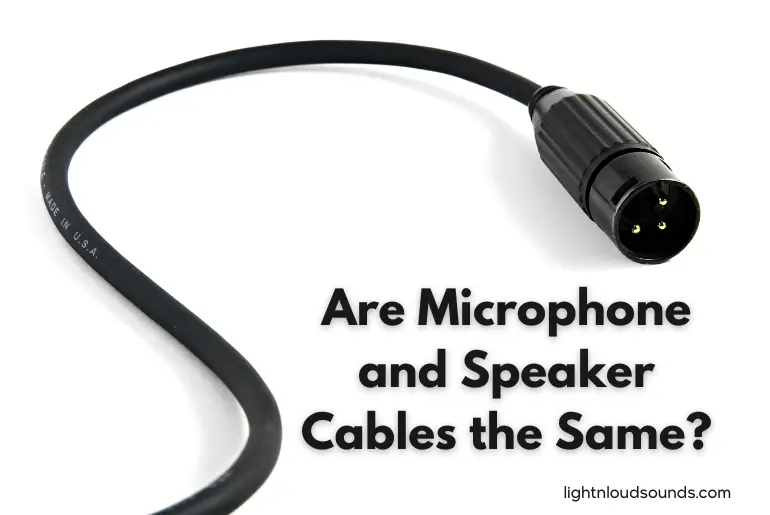When connecting audio equipment, cables become essential components, often raising a common query: are microphone and speaker cables the same? Navigating through the maze of audio hardware, it’s vital to understand the fundamental differences or similarities between these two types of cables.
Both serve the purpose of transmitting an electrical signal, yet are they interchangeable, or does each type possess unique characteristics and functionalities essential to the specific audio equipment they are designed to serve?
In this post, we’ll talk about the distinct elements of microphone and speaker cables, considering their design, purpose, and the potential impact on audio quality when they are utilized.
Post Contents
Are Microphone and Speaker Cables the Same?
No, microphone and speaker cables are not the same. While they both transmit electrical audio signals, they are designed for different purposes and are not interchangeable in most situations. Microphone cables are designed to carry low-voltage signals and typically have an XLR connector, providing a balanced signal that reduces interference over long distances.
On the other hand, speaker cables carry high-powered signals from an amplifier to a speaker, using connectors like 1/4-inch, Speakon, or banana plugs, and are built to handle higher voltage levels without compromising safety or sound quality. Using them interchangeably could result in compromised audio quality and potential damage to your audio equipment.
What Are the Differences Between Speaker Cable and Microphone Cable?
1. Signal Level and Power Handling
Microphone cables are designed to transmit low-level signals from the microphone to the audio interface or mixer. They usually deal with voltages in the millivolt range and are optimized for carrying these low-level, balanced signals.
On the contrary, speaker cables are meant to handle high power levels, transmitting amplified signals from an amplifier to a speaker, which requires robust construction to handle the greater voltage and current without heating up or introducing signal loss.
2. Connectors
The connectors found on microphone and speaker cables are usually different to align with their specific applications. Microphone cables commonly utilize XLR connectors, which provide a secure, locking connection and balanced signal transmission. Meanwhile, speaker cables typically employ 1/4-inch TS, Speakon, or banana plug connectors to handle higher power levels and ensure a robust connection between the amplifier and speaker.
3. Conductor Gauge
Speaker cables often have a larger conductor gauge compared to microphone cables, as they need to carry higher current levels without inducing resistance and subsequent signal loss. Larger conductors allow the speaker cables to transmit high-power signals efficiently. Microphone cables do not require as thick conductors since they transmit signals of significantly lower power.

4. Shielding
Microphone cables utilize a shield, usually made from copper wire or foil, which protects the inner conductor from external electromagnetic interference, ensuring a clean, noise-free signal. Speaker cables typically lack this extensive shielding since they transmit a much higher level power signal, making them less susceptible to interference and noise intrusion.
5. Flexibility and Durability
Microphone cables often prioritize flexibility and durability, as they are frequently handled moved, and may need to navigate through tight spaces. They are designed to resist wear and tear from frequent bending and coiling.
In contrast, speaker cables may often be more rigid and robust due to their larger conductor size and are typically subjected to less physical manipulation in setups.
6. Usage and Interchangeability
Using microphone and speaker cables interchangeably can lead to poor performance and potentially damage audio equipment. A speaker cable used in place of a microphone cable may introduce noise due to insufficient shielding.
On the other hand, using a microphone cable in a high-power speaker setup may result in overheating and signal degradation due to its lower power handling capabilities and smaller conductor gauge. It is crucial to use each cable type in its intended application to ensure optimal performance and safeguard audio equipment.
Can I Use a Speaker Cable for Mic?
While physically possible in some situations, using a speaker cable as a microphone cable is not recommended due to the specific design differences between the two. Speaker cables lack the shielding that microphone cables have, which is crucial for preventing interference and maintaining a clean signal in the latter.
The absence of this shielding in a microphone context, particularly in environments with various electronic devices, can lead to unwanted noise and compromised audio quality. Moreover, connectors may not always be compatible without adaptors since microphone cables commonly use XLR connectors, while speaker cables might use 1/4-inch, Speakon, or banana plugs.
Hence, even though a connection might be made, ensuring optimal audio performance and preserving equipment integrity requires using cables for their intended purpose.
What Cables Do Microphones Use?
Microphones predominantly use XLR cables due to their ability to transmit balanced audio signals, which minimizes noise and interference over longer cable runs. XLR cables have three pins: one for positive, one for negative, and one for ground, facilitating the transmission of balanced audio by allowing the signal to travel along both the positive and negative paths.
When the signal is received, any noise that has been picked up along the cable is canceled out due to the phase inversion of the negative signal. This capability makes XLR cables particularly valuable in professional audio environments where long cable runs and potential interference sources are common.
Also, some microphones, especially in consumer or certain specialized applications, might use other cable types such as USB, mini-XLR, or 3.5mm TRS, catering to different connectivity requirements.
Conclusion
Microphone and speaker cables, though superficially similar, have been revealed to possess critical differences in design and application, thereby making them non-interchangeable in most audio setups. Understanding these differences is paramount to optimizing audio performance, protecting equipment, and ensuring that signals are transmitted with utmost fidelity. The speaker cables, designed to carry amplified signals, contrast with microphone cables that are built to transport low-voltage signals while also resisting interference.

